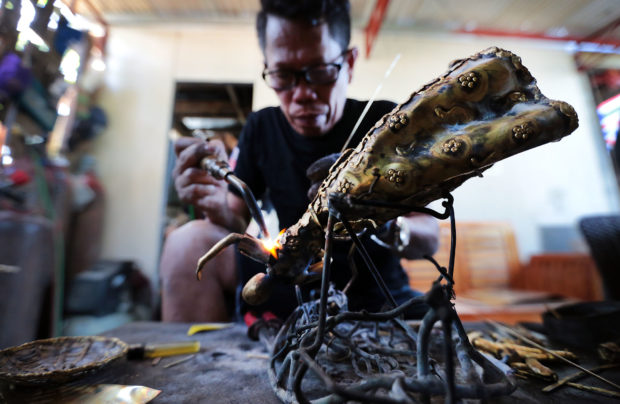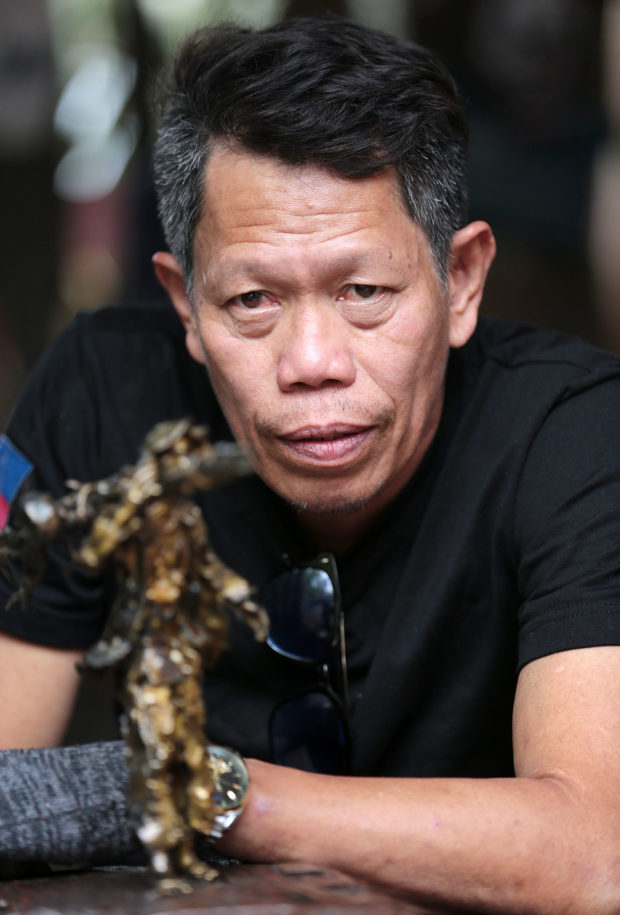Artists’ apprentice comes into his own more than 30 years later

HUMBLE BEGINNINGS: As a young boy, the artist’s family was poor so he had to make his own toys from bamboo. (Photo by GRIG C. MONTEGRANDE / Philippine Daily Inquirer)
MANILA, Philippines — Whenever Bernardo Glomar went home to their house in Barangay Tanza Uno, Navotas City, he would gaze at the scenery that seemed like an artwork in motion: a large tree with birds perched on its branches, fishermen casting their nets out at sea, boats swaying to the lazy rhythm of the wind, and lovers meeting in the shadows.
It wasn’t long before the 55-year-old Glomar, who had spent nearly half of his life assisting renowned sculptors, decided to use these scenes as inspiration for artwork featured in a recent exhibit at the House of Representatives.
“Before I worked for the Cacnios, I worked with my family of farmers in Sorsogon. And when we came to Navotas in 1981, I sometimes worked as a fisherman, too,” Glomar told the Inquirer in a recent interview.
He was around 20 years old when he went to work as a house helper for the Cacnios, a family of artists, together with his sister.
Love for the arts
But it was when he began helping famed brass sculptor Michael Cacnio craft pieces for school projects that Glomar developed a love for the arts. He started out cutting scraps of metal in the shape of leaves and slowly molding and welding the smallest details into them, and before he knew it, he was sculpting tree trunks and dresses for art pieces that would soon be recognized as world-class.
However, after working on the sidelines and in the shadow of Cacnio, his brother Ferdinand Cacnio and their cousin, Angelito Cacnio, Glomar found himself unhappy at the thought of staying unknown despite his talent that he knew could lead to boundless opportunities.“I decided to quit,” he said. “I stayed with them even after I had my own family and grandchildren. But after around 30 years of helping the Cacnios, I decided to go forward on my own.”
In 2017, he started making his own creations in a makeshift workshop outside their cramped house in Navotas, beginning with “Si Tatay,” a 12-inch brass sculpture that was the image of his father carrying wood and coconut shells, armed with a bolo and walking along the fields of Sorsogon.
Surrounded by his “weapons”—welding tools and cutout pieces of brass—he worked on the piece for three days straight with the help of his son Romer and son-in-law Josso.
Romer was in charge of cutting small pieces from metal scraps they bought in Manila, while Josso welded these into shape and added minor details.
“We’re only here to execute steps 1 and 2 of the process. But when it comes to building the entire image together, it’s all him,” Romer said.

SOURCE OF INSPIRATION The former apprentice takes inspiration from everyday scenes in his hometown of Navotas City. —GRIG C. MONTEGRANDE
No prior experience
Before Glomar came to work for the Cacnio family as their houseboy, he had no experience in sculpting, although as a boy born to a poor family, he had to build his own toys like spinning tops and wagons from bamboo.
It was while assisting the Cacnio brothers and their cousin that he began to learn the craft.
That is why seeing Glomar’s “Tree” sculptures may evoke a sense of familiarity.
More than 30 years of dabbling in sculpting have left their mark on him, the most obvious the burn marks on his body, with one particular scar on his foot shaped like the legs of Ferdinand Cacnio’s “Dancer.”
“We couldn’t get it off my foot for days,” Glomar recalled. “That’s when I finally learned to always use gloves and be alert at work.”
As one of the 40 artists invited to join the “Art at the House 3” exhibit at the Batasang Pambansa complex in Quezon City, he admits to being dumbfounded whenever art lovers compliment him on his work.
“When I saw my pieces featured in a gallery, I couldn’t help but tear up a bit. I remember feeling goosebumps all over my body,” he said.
One of his signature tree sculptures sold for around P100,000 in the exhibit, even as his daughter rode on the strong wave of technology and began selling his work online.
“Even as he sells his sculptures online and through exhibits, we’re not a wealthy family by any means,” Glomar’s wife, Irma, said. “The only wealth we have is fellowship with others.”
Helpful neighbor
Although he has made enough money to buy his dream motorcycle that makes transporting his artwork easier, most of Glomar’s savings are being used to help out their neighbors and colleagues at Tanza Uno.His house remains modest, made mostly of plywood and layers of tarpaulin acting as a roof to protect the family of eight, and they are in fear of soon losing the only structure that connects them to the Navotas community.
Still, he clings to the source of his inspiration for his art.
“This is the pride of Navotas: fishermen, vendors, children, sea creatures and birds. I’ve lived most of my life seeing this scenery before me. Why would I choose anything else?” he said.